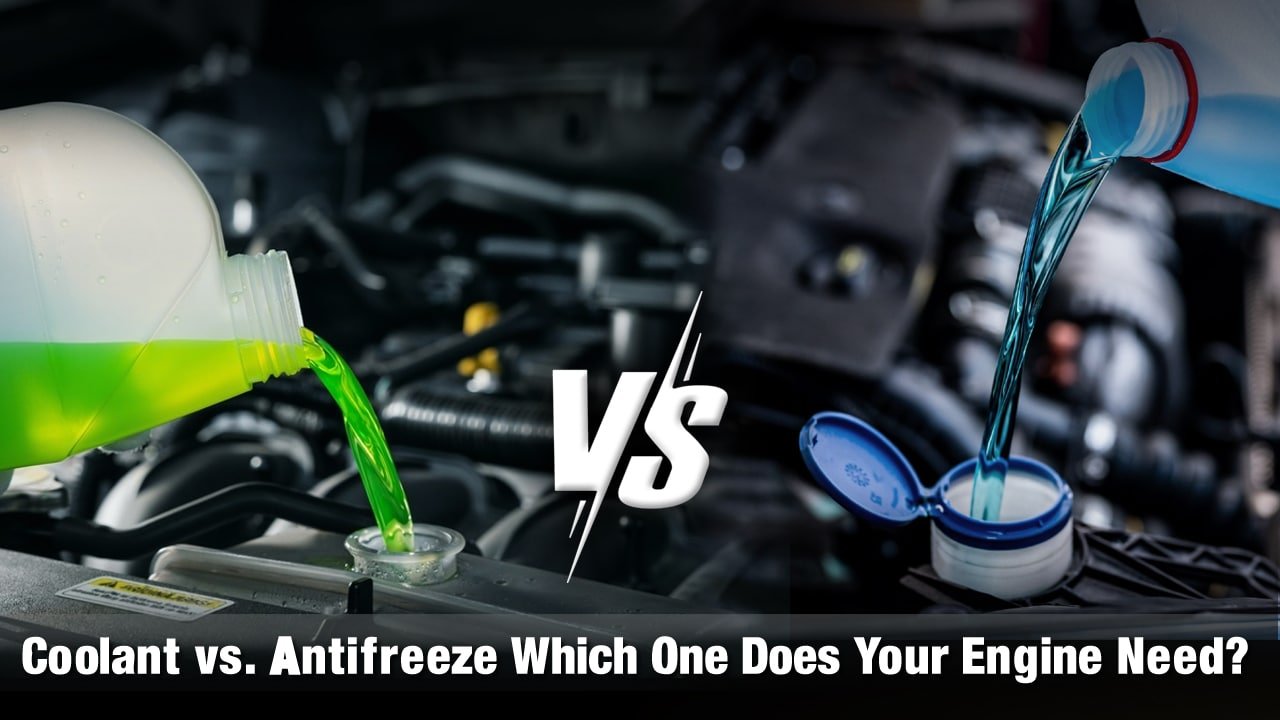
Ever wonder if your car needs coolant or antifreeze? Don’t worry—you’re not alone! Many people think they’re the same thing, but they’re a bit different. Coolant helps keep your engine from overheating, while antifreeze prevents it from freezing in cold weather. Both are super important to keep your engine running safely and smoothly.
In this guide, we’ll break down the differences between coolant and antifreeze, explain how they work, discuss when to change them, and explain why using the right one is essential. Let’s dive in and make sure your engine gets the care it needs—no matter the weather!
Key Takeaways
- Coolant is a liquid that goes in your car’s radiator. It helps keep the engine from overheating.
- Antifreeze is a special chemical mixed with coolant or water. It stops the engine from freezing in cold weather.
- You should mix coolant and antifreeze in a 50:50 ratio – half and half.
- It’s essential to check your coolant level often. Add more if it’s low.
- Always ensure that the coolant and antifreeze match your car’s specifications before use.
Coolant
Coolant is a liquid that helps keep your car’s engine cool. It moves through the engine and takes away the heat. This enables the engine to maintain the correct temperature, thereby preventing overheating.
Antifreeze
Antifreeze is a liquid that stops your engine from freezing in cold weather. It works by lowering the temperature at which water freezes. You mix antifreeze with water or coolant—half and half (50:50). This mixture keeps the liquid from turning to ice when it’s extremely cold. You can buy antifreeze already mixed with water, but it usually costs more.
Types of Engine Coolants
There are two main kinds of engine coolants: organic and inorganic.
- Organic coolants are the most common. They’re made from chemicals like ethylene glycol or propylene glycol.
- Inorganic coolants have silicates or phosphates. These are primarily used in older cars.
You can also pick between conventional and extended-life coolants:
- Conventional coolant contains silicates, which can accumulate over time and cause damage.
- Extended-life coolant doesn’t have silicates and can last up to 5 years or 100,000 miles.
When Should You Change Engine Coolant?
You should change your engine coolant every 2 years or after 24,000 miles, whichever comes first.
Antifreeze doesn’t need to be changed as often, but it’s still a good idea to check the level regularly to ensure it’s correct.
When changing the coolant, ensure it’s the correct type for your car. You can find this information in your car’s manual or on the radiator cap.
If your engine feels hotter than usual or you see leaks, there may be a problem with the cooling system. That means it’s time to take your vehicle to a mechanic.
How Does It Work?
Your car has a cooling system that keeps the engine from overheating. This system includes the radiator, water pump, thermostat, hoses, and fan.
Here’s how it works:
The engine coolant circulates through the engine, absorbing heat as it does so. Then it flows to the radiator, where the heat is released into the air. Cool air blows over the radiator fins, helping the coolant cool down. Once it’s cool, the coolant returns to the engine to repeat the process.
Antifreeze is mixed with the coolant. It helps in two ways:
- It stops the coolant from freezing in cold weather.
- It raises the boiling point, allowing the coolant to hold more heat before boiling.
Antifreeze also has special chemicals to protect your engine from rust and corrosion.
If you’re unsure which coolant to use, consult a trusted mechanic for guidance. They can help you choose the right one and answer any questions you may have.
How Are Engine Coolant and Antifreeze Made?
The method of producing engine coolant and antifreeze can vary slightly depending on the brand. However, most of them begin with a primary ingredient known as ethylene glycol. This type of alcohol lowers the freezing point of water, which helps keep your engine safe in cold weather.
Important: Ethylene glycol is poisonous to people and animals. Always keep it out of the reach of children and pets.
Manufacturers also add extra chemicals to make the coolant work better:
- Silicates help stop rust and corrosion inside the engine.
- Borates also protect the engine and raise the boiling point, allowing the coolant to handle more heat.
These added ingredients help the coolant perform more effectively, keeping your engine safe and running smoothly.
Main Difference
Antifreeze is a liquid primarily composed of a chemical called ethylene glycol. It helps stop water from freezing, which protects your engine in cold weather.
Engine coolant is a mix of water and antifreeze. Most of the time, it’s a 50/50 mix, but sometimes it can be 70% water and 30% antifreeze.
So, the big difference is:
- Antifreeze is just a chemical.
- Coolant is antifreeze mixed with water.
You can buy premixed coolant, which is ready to use. Alternatively, you can purchase concentrated antifreeze, which requires mixing with water yourself.
- Premixed is easy to use, but costs more.
- Concentrated is cheaper, but you have to mix it correctly.
Time to Replace Your Coolant
Coolant doesn’t last forever. It needs to be replaced regularly. How often depends on the type of coolant and your car’s manual.
- Some coolants last up to 5 years or 100,000 miles.
- Others need to be changed every 30,000 miles.
Why Flushing the Coolant Is Important
Over time, coolant can become contaminated with rust, dirt, and other debris. This can clog the radiator and mess up your cooling system.
If you don’t change it on time, it can even become corrosive and damage your engine, potentially leading to expensive repairs.
That’s why it’s a good idea to flush your coolant every 2 years.
How to Flush Coolant
To flush it, you need to:
- Drain the old coolant from the radiator.
- Refill it with fresh coolant.
You can do it yourself by following your car’s manual, or have a mechanic do it.
Don’t overfill the radiator. Follow the correct steps to keep your car running smoothly.
Benefits of Antifreeze
Antifreeze helps your engine in three significant ways:
- Stops Overheating: Antifreeze absorbs heat from the engine and dissipates it into the air. This keeps the engine at the right temperature, even when you’re driving a lot.
- Prevents Rust and Corrosion: Antifreeze creates a protective layer inside the engine. It keeps metal parts from rusting or getting damaged by water.
- Stops Freezing in Cold Weather: When it’s cold outside, antifreeze helps your engine stay liquid. It lowers the freezing point so the coolant doesn’t turn into ice, even in chilly weather.
Signs Your Car Needs Coolant or Antifreeze Service
Here are some signs your car may need a coolant or antifreeze check-up:
- The temperature gauge goes too high.
- You see a sweet-smelling liquid under the hood.
- There’s rust in the coolant tank.
- You keep needing to add more coolant or water.
- Radiator hoses feel stiff or brittle.
- Steam comes from under the hood.
- The car heater isn’t working well.
If you notice any of these, take your car to a mechanic for a coolant service. This helps your engine stay strong and run better.
How Antifreeze and Engine Coolant Work
Antifreeze and engine coolant work together to protect your car’s engine in hot and cold weather. This radiator fluid is a mix of special chemicals that help the engine stay cool in the summer and warm up evenly in the winter.
It also contains corrosion inhibitors that prevent rust and dirt from accumulating inside the engine.
Here’s how it works:
The coolant flows in a loop through your engine, heater, and radiator. It carries away heat from the engine when it’s too hot and helps warm it up when it’s cold. Then it cools down in the radiator and starts the cycle again.
Car manufacturers design their coolants to handle various weather conditions and to fit each engine type.
If you don’t have enough coolant, your engine can overheat or even stop working, which can cause severe damage and leave you stranded.
Coolant vs. Antifreeze – What’s the Difference?
People often mix up coolant and antifreeze, but they are not the same thing.
- Antifreeze is a liquid added to water to stop it from freezing in cold weather.
- Coolant is a mixture of water and antifreeze that helps keep your engine cool while also protecting it in cold weather.
The main difference is what they’re made of:
- Coolant typically contains ethylene glycol, which cools more effectively but is more toxic.
- Antifreeze often has propylene glycol, which is less toxic but doesn’t cool as well.
- Use coolant only in well-ventilated areas, and always keep it away from kids and pets.
- Antifreeze is a bit safer to use around people and animals, but not as strong at cooling.
- Coolant can act as antifreeze, but antifreeze alone should not be used as coolant.
Why Should You Change Your Engine Coolant?
Coolant helps keep your engine from overheating and also prevents rust and corrosion. However, over time, coolant can become contaminated with substances such as oil, grease, and dust. This makes it less effective.
That’s why it’s essential to change your coolant on a regular basis. Flushing out the old coolant and adding new fluid helps your engine stay cool and run smoothly. It’s a simple job, but it can help prevent big engine problems later.
Why Should You Change Your Antifreeze?
Just like other car fluids, antifreeze gets old over time. It can become acidic and start to cause damage to components such as the radiator, water pump, thermostat, hoses, and more.
Old antifreeze can also collect rust, dirt, and gunk. This makes it harder for the antifreeze to keep your engine cool. If it doesn’t work correctly, your engine might overheat or even get severe damage, like piston welding.
So, don’t wait too long to change your antifreeze—it helps keep your engine healthy and safe!
Final Takeaways
Your car’s engine works hard, and coolant and antifreeze are what help keep it safe and cool in the summer and protected in the winter. These fluids circulate through the engine, carrying away heat and preventing it from freezing when temperatures drop. But like all car fluids, they don’t last forever. Over time, they break down and lose their power.
That’s why it’s crucial to replace them every 30,000 miles or every two years. Taking care of your coolant system is a simple step that can save you from big engine problems down the road.
FAQs
Q1: What is the primary function of coolant or antifreeze?
Coolant, also known as antifreeze, helps prevent your engine from overheating in hot weather and freezing in cold weather. It allows the engine to stay at the right temperature. Using the right mix protects the engine from damage.
Q2: Can I add antifreeze to my engine coolant?
Yes, but only if it hasn’t already been mixed. Always mix antifreeze 50:50 with water before adding it to the engine. Using straight antifreeze can reduce cooling performance and harm your engine.

Editor-at-Large
A passionate writer in the lubricant industry, Awais Iqbal has been covering oils, greases, and industrial fluids since the start of his career. At 25, he’s already written for blogs, catalogs, and brand guides across the UAE. Awais’s insights help companies connect with their audience, and his clear, helpful writing style is trusted by brands in the region.


